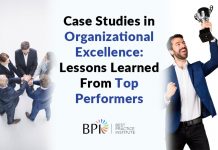Strategy is no longer the sole component of integrating talent management. Innovative organizations are thriving by using technology and transforming culture to integrate their talent management strategies.
For organizations to succeed, they must attract, maintain and develop the right people. During the last decade, organizations have sought new ways to streamline their people, processes and operations. With Integrated Talent Management (ITM), executives can make real-time decisions more effectively. Talent data becomes readily available, and communication across silos is made simple.
In a Best Practice Institute (BPI) research study, it was found that the number one driver for integrating talent management was the need to align business strategy, and to align employee goals with business goals. While 40% of surveyed executives said they are being given the opportunity to integrate their talent management systems, only 13% believe their organizations have the competency to integrate their systems.
Many Organizations do not know where to start with such a vital but complicated process. The place to begin with ITM is the transformation of people, processes and operations.
Consultants advising BD Japan said the most important critical success factor in integrating talent management is: “A ‘whole systems’ approach to organization transformation and change.” By taking this approach, BD revenues have risen 130%.
BPI’sstudy identified five simple steps that will help organizations begin the Integration Process.
Five Steps for Integration

(1) Pick a Team: Organizations must decide who will lead the integration process. The BPI study found that 48% of organizations charged the Human Resources department with leading the change and identified a C-level executive as the change agent. At E.W. Scripps, the integration process was led by the Director of HR Operations and the Vice President of Talent Management. Clearly, organizations with a strong team and C-level support have the most success achieving integration.
(2) Decide on a Focus Area: Each organization in BPI’s study had an area that was the main focus of their integration effort. At CDW, Performance Management and Succession Planning were the catalysts for integration. E.W. Scripps assigned project teams to ensure that the talent management strategy addressed the business needs of Performance Management and Learning & Development. The BPI study found that Learning & Development and Performance Management are the highest priority for integration among the corporations surveyed.
(3) Choose your Talent Software Vendor: Pick a vendor based on the most important areas of your business strategy. Invite vendors to present to your top team,: How well do their modules fit your needs? Can they be easily integrated? What about usability? Can employees understand the technology? Destination Hotels & Resorts asked to interview other customers of their final three vendor candidates. Best of Breed vs. Full Suite has been an argument in the Talent Management Software. Larry Mohl, former CLO of Atlanta Children’s Healthcare, said that by committing to the full talent suite, Children’s Healthcare was able to have the vendor’s ear and save on costs overtime.
(4) Create Buy-in: The third driver of integration is Cultural Transformation [I’m confused by this point. When you used the word “driver” on P 1, it was referring to the motive for ITM. However, here “driver” seems to be referring to a necessary step to achieve ITM]. Executives say that finding a norm around the language of Talent Management is an important first step. Integration of technology must be simple and user friendly. Destination Hotel & Resorts made sure that all employees received training and that they understood the “why” of the new system. At Bombardier, the first phase of their Integrated Talent Management strategy was to focus on transforming the knowledge and vocabulary used for Talent Management. Once the language of ITM was established, they moved on to Phase 2: integrating and connecting systems.
Only 10% of organizations reported that they have evaluations in place to measure the effectiveness of ITM.
(5) Train, Sustain and Maintain: Integration does not stop with a single user sign-in and data-sharing process. To sustain ITM, organizations must evaluate how the strategies and processes are working inside the organization. Only 10% of organizations reported that they have evaluations in place to measure the effectiveness of ITM. 39% of organizations said that they reinforce their strategies but have not implemented evaluations. Kevin McDonald, VP of Governance, said, “If you don’t take a holistic, long-term approach upfront, you will pay for it later.” Creating the right partnerships both internally and externally proved invaluable to Scripps in the development and execution of their distinctive Integrated Talent Management program. Destination understood the importance of training to sustain ITM. Robert Mellwig, Senior Vice President Human Resources, Destination Hotel & Resorts, said that cultural transformation was successful because they maintained the idea that they were “building toward something.”
The Model
Best Practice Institute interviewed more than 200 Talent Management and Corporate HR Executives about their efforts to integrate talent management. We then worked with the BPI Senior Executive board, which is composed of the talent leaders of some of our nation’s largest corporations, to develop a new model for Integrated Talent Management.
Early models in the TM field began as functional models to help organizations manage different parts of talent processes. During the past decade models began to incorporate different areas of Talent Process including Leadership Development and Succession Planning. These renditions are more inclusive but are not Business Strategy-focused and do not show how talent processes communicate with each other.
The future of the Integrated Talent Management model is moving in the direction of more inclusiveness. It encourages communication and supports the five steps of integration described above. Drawing upon its extensive research, BPI has developed a model that guides organizations to talent management integration with a Business Strategy focus.

Research shows that organizations with successful ITM communicate clearly across their talent processes. Encouraging communication of leadership and data is critical to the new ITM Model. Each spoke of the wheel is connected through the HR Technology. Systems and people are able to easily access each other.
BPI’s Talent Mobility survey indicated that talent visibility is critical to development and mobility. Schneider Electric has shifted from individual HRIS and TM Tools to a comprehensive and unified HRIS and Talent Management system. Visibility allows the company to track talent movement, look at employees’ career development and how they are performing. The HR Transformation that occurred at Schneider allowed them to break down technical and process barriers. The company now has one system across its 29 entities.
“Moving to the shared services HR model has allowed us to break down barriers and become more harmonized. It has been great for mobility and talent management, said Yvette Stortz, Director of Talent Acquisition & Mobility. “We can have conversations around the same data and the same measurements.”
The modular approach to Talent Management creates communication and assessment throughout the employee life cycle and the factors that influence their life span. If compensation and benefits are not integrated with performance management, what happens to employees? Often, a lack of data alignment creates frustration. The alignment begins with the organizational design, which is vital to how each phase aligns with the overall business goal This also determines who from each spoke will be guiding the Integrated Talent Management process.

To encourage the success of the ITM Model, the outer ring incorporates design elements that allow for the system and processes to be continually assessed, implemented and evaluated. The circle indicates that this is a continual process for organizations on the road to integration. BPI’s ITM survey showed that only 10% of organizations evaluate the effectiveness of their integrated talent management strategies and models compared to nearly 80% of our best practice case study organizations actually achieving ITM.
Putting the Model into Play
With the new integrated model in play, the remaining 62% of organizations are confident in how they will implement and succeed with Integrated Talent Management. Beginning the transformation process is critical to integration success. Organizations that want to use new models need to create new mindsets among their top leadership and filter the changes into the rest of the organization.
CDW’s Director of Organization Capability, Tess Reinhard, Sr., ensured transformation by meeting with each director to layout the new plan and roles that would be required for integration. “The information we got from this process was brought back together to ensure alignment,” said Reinhard.
After BD Japan integrated its talent management process, it gained 130% in revenue.
In BD Japan’s case it is clear that without transformation, the process would not have been as successful. “The talent upgrade was a part of a larger and more detailed transformation process, said Jay Romans Talent/HR Executive at BD. “Customer and stakeholder needs were analyzed, the vision for the company was defined, and the near-term objectives were determined.”
Similarly, Amway is continually transforming its processes from the top down. Critical conversations around alignment of goals and processes occur, beginning with top leaders and dispersing into different groups. “The alignment sessions in essence are open communication sessions between leaders of different groups,” said Kee Meng Yeo, Amway’s VP of Global Talent Management. As Amway addresses the development needs and alignment of its employees and processes, it is also identifying and developing key talent and future leaders.
Where Do We Go Next?
One thing is certain integration of talent management will only succeed when an organization transforms itself and becomes transparent. The top team and whole system must embrace the need to integrate and fully engage in the system. For this to occur, integration and new talent systems must be developed from the inside with the clear help of external experts and vendors from the outside. It must be a clear, data-driven process based on the clear direction of all stakeholders within.
* * * * *
Louis Carter is founder and CEO of Best Practice Institute and the author of several books, including Best Practices in Leadership Development and Organization Change The Change Champions Field Guide and In Great Company. He is a highly regarded authority on learning, talent, leadership development and change, providing executive coaching, training, and development in organizational culture, talent management and achieving peak performance. He was voted as one Global Gurus Top Organizational Culture thought leaders worldwide. He also been touted as the #1 leadership development and talent management thought leaders.
Patrick Carmichael, Vice President of Best Practice Institute, provides consultation to senior executive peer groups of Fortune 500 companies. A former member of Saudi Aramco’s Employee Relations and Training Management team, Carmichael has more than 35 years of experience in organization development, international training and cross-cultural development. Patrick was the recipient of the 2010 Roger Fisher Lifetime Achievement Award.










